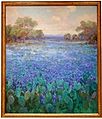J. Wayne Stark Galleries facts for kids
 |
|
| Established | 1992 |
|---|---|
| Location | Texas A&M University, College Station, Texas |
The J. Wayne Stark Galleries is an art museum located at Texas A&M University in College Station, Texas. It is managed by the University Art Galleries Department. This department is part of the Division of Student Affairs at the university. The art gallery is named after J. Wayne Stark, who was the first director of the Memorial Student Center.
Contents
History of the Stark Galleries
The idea for the museum started in 1973. This is when the Office of University Art Collections and Exhibitions was created. J. Wayne Stark led this office. His job was to help develop cultural programs at the university. This office started to list all the art the university already owned. They also began to get new art pieces.
In 1990, construction began on the Stark Galleries building. This was possible thanks to a generous gift from Sara and John H. Lindsey. Other people and the university also helped with funding. The Stark Galleries first opened to the public in February 1992.
The Memorial Student Center, where the galleries are, had a big renovation starting in 2009. Because of this, the Stark Galleries were temporarily closed. Mary and James B. Crawley gave a large donation for this renovation project. The gallery reopened on April 21, 2012. It now has about 10,000 square feet of space for art. This includes four galleries, places for events, and a room for learning. The Crawley Gallery and the Lindsey Gallery are named after these important donors.
The University Art Galleries Department plans all the activities for the Stark Galleries.
Who Was J. Wayne Stark?
John Wayne Stark was born on December 16, 1915, in Lamesa, Texas. He finished high school in Winters, a small town in West Texas. In 1939, he earned a history degree from Texas A&M. He then studied law at the University of Texas. However, he left before finishing to serve in World War II.
In 1947, he came back to Texas A&M. He started working on building the Memorial Student Center. In 1959, he became the Texas A&M sponsor for a program called Experiment in International Living. This program helped about 400 A&M students travel overseas. They could live and work in other countries. Stark worked for the university for 33 years. He retired in 1980. But his impact continued at the university and in the community.
In 1992, university leaders named the Stark Galleries after him. This was to honor his strong belief in and support for the arts.
Art Collections at the Galleries
Before the Stark Galleries were built, art shows were held in other places on campus. These included Rudder Exhibit Hall. Today, the museum has nearly 10,000 art pieces. Most of these are American art from the 1800s and 1900s. There is a special focus on art and artists from Texas.
Over the years, the collection has grown mostly through donations. Visitors can also find other types of art. These range from ancient pottery made before Columbus to German paintings from the 1800s.
The museum's main collection also includes sculptures and other decorative art. The Stark Galleries also looks after 23 outdoor sculptures on campus. These include works by famous artists like Pompeo Coppini, Lawrence Ludtke, Veryl Goodnight, and Hans Van de Bovenkamp.
Featured Artists and Artworks
The main collection at the Stark Galleries focuses on American paintings, prints, drawings, and photos. These are mostly from the 1800s and 1900s. Some of the artists whose work you can see include Dawson Dawson-Watson, Julian Onderdonk, H.O. “Cowboy” Kelly, Peggy Bacon, Laura Gilpin, Charles Schorre, and Dorothy Hood.
- Harold Osman "Cowboy" Kelly (1884–1950): Kelly is known as one of the most important "folk" artists of the 1900s. He made only a few works in his life. Yet, his art is famous around the world in the folk art style. He was born in Ohio. Most of his art shows farm life in the Midwest. It also shows his adult life in Texas. Some of his well-known works are “More Good People” and “Fourth of July Races.” The J. Wayne Stark Galleries has the largest collection of his original works.
- Dorothy Hood (1919–2000): Hood was born in Bryan, Texas. Modern art, philosophy, poetry, and early space travel greatly influenced her. Her art mixes abstract and geometric shapes. She creates unique designs that show her wonder about the universe. Many of Hood’s works are in important art collections. These include 23 museums in the U.S. and others in Switzerland and Mexico City. The J. Wayne Stark Galleries proudly owns two of her original masterpieces: “The Day the Mountain Thanked the Sea” and “Space Riders.”
- Dawson Dawson-Watson (1864–1939): Born in London, Dawson-Watson lived and painted across Europe. He then moved to the United States. He worked at important art colleges. First, he was a director in Connecticut. Then, he was a teacher in St. Louis. Later, he moved to San Antonio, Texas. There, he began painting the plants of the Southwest. His time in Texas led him to paint scenes of the Grand Canyon. This series is what he is most famous for now. The J. Wayne Stark Galleries has three of his beautiful landscape paintings.
- Edward M. "Buck" Schiwetz (1898–1984): Schiwetz was born in Cuero, Texas. He studied architecture at Texas A&M University. However, he never worked as an architect. He taught himself to be an artist. After graduating, he moved to New York. There, he became known for his skill in many art forms. He became more famous and started his own advertising company. Even after facing serious health problems, he worked as an artist for Texas A&M University's 100th anniversary in 1976. During this time, he created a collection of scenes from the university. Schiwetz was a very productive artist. His works are in major museums worldwide. The J. Wayne Stark Galleries has one of the largest collections of his original works in a public museum.
- Julian Onderdonk (1882–1922): Onderdonk was born in San Antonio, Texas. He trained on the East Coast for several years. Then, he returned to his hometown to paint. His most famous works are his "bluebonnet" landscapes. Three of these were in the Oval Office at the White House during the George W. Bush presidency. A gallery dedicated to his work is at the Dallas Museum of Art. Texas A&M University has two of his works: “Miles and Miles of Bluebonnets” and “At the Edge of the Forest.”
Campus Sculptures
Texas A&M University has 23 sculptures located around the campus. Some of these sculptures were created by well-known artists. These include Lawrence M. Ludtke, Pompeo Coppini, and Hans Van de Bovenkamp.
- James Earl Rudder by Lawrence M. Ludtke (1929–2007)
- Twelfth Man by George E. "Pat" Foley (1922–1998)
- Lawrence Sullivan Ross by Pompeo Coppini (1870–1957)
- Silver Taps by Rodney Culver Hill
- Menos by Hans Van de Bovenkamp
- Victory Eagle by Kent Ullberg
Images for kids





